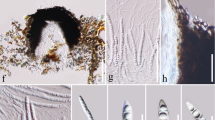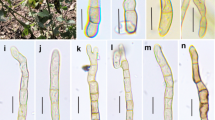Abstract
Our recent molecular phylogenetic study revealed a previously unrecognized clade of six species that is sister to Elaphoglossum. Within this clade, four species are currently classified in Bolbitis, one in Lomagramma, and one in Acrostichum. For this clade, we propose the name Mickelia, with M. nicotianifolia as the type species. We also make new combinations for the species in our phylogenetic study shown to belong to Mickelia (M. bernoullii, M. guianensis, M. hemiotis, M. nicotianifolia, M. oligarchica, and M. scandens) and two other species believed to belong to the clade based on morphology (M. lindigii, M. pergamentacea). A new hybrid and two new species are also described (M. ×atrans, M. furcata, and M. pradoi). In total, Mickelia consists of ten species and one hybrid. It is entirely neotropical. We provide a key to the genera of bolbitidoid ferns and a synopsis of Mickelia that gives for each species a complete synonymy, geographical distribution, comparative discussion, and illustration.
Resumo
Análises filogenéticas recentes revelaram a existência de uma clado composto por seis espécies, irmão de Elaphoglossum. Das espécies incluídas nestas análises, quatro são atualmente tratadas em Bolbitis, uma em Lomagramma, e uma em Acrostichum. A este clado propomos o nome Mickelia , com M. nicotianifolia sendo sua espécie-tipo. Neste trabalho são apresentadas as novas combinações para as espécies de Mickelia, tanto as que foram tratadas nas análises filogenéticas (M. bernoullii, M. guianensis, M. hemiotis, M. nicotianifolia, M. oligarchica e M. scandens), quanto para duas outras que são aqui incluídas com base em evidências morfológicas (M. lindigii e M. pergamentacea). Um híbrido novo e duas espécies novas são também descritos (M. ×atrans, M. furcata e M. pradoi). No total, Mickelia compreende dez espécies e um híbrido. O gênero é inteiramente neotropical, e é caracterizado pelo hábito hemiepifítico, nervuras anastomosadas, e pela ausência de gemas (essas, se presentes, surgindo próximas à junção da pina com a raque). São apresentadas uma chave para os gêneros das samambaias bolbitidoides, e uma sinopse para Mickelia contendo uma lista completa de sinônimos, dados sobre distribuição geográfica, discussões comparativas e ilustrações.









Similar content being viewed by others
Literature Cited
Ching, R. C. 1932. The genus Lomagramma in America. American Fern Journal 22: 15–18.
Christ, H. 1899. Monographie des genus Elaphoglossum. Neue Denkschriften Allgemeinen Schweizerishcen Gessellschaft für die Gesammten Naturwissenschaften 36: 1–159, + tab. 1–4.
Christensen, C. 1904. On the American species of Leptochilus sect. Bolbitis. Botanisk Tidsskrift 26: 283–300.
———. 1936. The collection of pteridophyta made in Hispaniola by E. L. Ekman 1917 and 1924–1930. Kungliga Svenska Vetenskapsakademiens Handlingar, ser. 3, 16: 1–93, + 20 plates.
Gay, H. 1993. The architecture of a dimorphic clonal fern, Lomagramma guianensis (Aublet) Ching (Dryopteridaceae). Botanical Journal of the Linnean Society 111: 343–358.
Hebant-Mauri, R. & H. Gay. 1993. Morphogenesis and its relation to architecture in the dimorphic clonal fern Lomagramma guianensis (Aublet) Ching (Dryopteridaceae). Botanical Journal of the Linnean Society 112: 257–276.
Hennipman, E. 1977. A monograph of the fern genus Bolbitis (Lomariopsidaceae). Leiden Botanical Series 12: 1–331.
——— & R. C. Moran. 1995. Bolbitis. Pp. 247–250. In: G. Davidse, M. Sousa S. & S. Knapp (eds.). Flora Mesoamericana, volumen 1, Psilotaceae a Salviniaceae. Universidad Nacional Autónoma de México, Ciudad Universitaria.
Holttum, R. E. 1937. The genus Lomagramma. Gardens’ Bulletin Straits Settlements 9: 190–221.
———. 1978 Lomariopsis group. Pp. 255–330. In: G. G. J. van Steenis & R. E. Holttum (eds.). Flora Malesiana, series 2, Pteridophyta, ferns and fern allies. Volume 1, part 4.
Lellinger, D. B. 1993. Nomenclatural and taxonomic notes on the pteridophytes of Costa Rica, Panama, and Colombia, III. American Fern Journal 93: 146–151.
Mickel, J. T. & A. R. Smith. 2004. The pteridophytes of Mexico. Memoirs of the New York Botanical Garden 88: 1–1055.
Moran, R. C., M. Sundue & P. Labiak. 2010. Phylogeny and character evolution of the bolbitidoid ferns (Dryopteridaceae). International Journal of Plant Science 175: 547–559.
Pichi Sermolli, R. E. G. 1969. Adumbratio Florae Aethiopicae. 18. Lomariopsidaceae. Webbia 23: 379–396.
——— & M. P. Bizzari. 2005. A revision of Raddi’s pteridological collection from Brazil (1817–1818). Webbia 60: 1–393.
Schuettpelz, E. & K. M. Pryer. 2007. Fern phylogeny inferred from 400 leptosporangiate species and three plastid genes. Taxon 56: 1037–1050.
Tryon, A. F. & B. Lugardon. 1991. Spores of the Pteridophyta: surface, wall structure, and diversity based on electron microscope studies. Springer-Verlag, New York.
Tryon, R. M. & A. F. Tryon. 1982. Ferns and allied plants, with special reference to tropical America. Springer-Verlag, New York.
——— & R. G. Stolze. 1991. Pteridophyta of Peru, Part IV, 17. Dryopteridaceae. Fieldiana, Botany, new series 27: iii + 1–176.
Walker, T. G. 1966. A cytotaxonomic survey of the pteridophytes of Jamaica. Transactions of the Royal Society of Edinburgh 66: 169–237.
———. 1985. Cytotaxonomic studies of the ferns of Trinidad 2. The cytology and taxonomic implications. Bulletin of the British Museum (Natural History), Botany 13: 149–249.
Acknowledgments
This research was funded by a grant to the first author from the United States National Science Foundation (DEB 0717056). Labiak’s research at the New York Botanical Garden was partially funded by the Brazilian government (CNPq/PDE 201782/2008-1). We thank Alan R. Smith, Jefferson Prado, and Fernando Matos for helpful information about specimens, and Judith Garrison Hanks for help in taking the SEM photomicrographs of the spores. We are grateful to David Barrington and Thomas Janssen, who provided many helpful comments on the manuscript. We thank John Mickel for allowing use of the line illustration for Fig. 5, drawn by Bobbi Angell, from The Pteridophytes of Mexico. The line illustrations in Figs. 2, 6, 8, and 9 were prepared by Haruto Fukuda.
Author information
Authors and Affiliations
Corresponding author
Rights and permissions
About this article
Cite this article
Moran, R.C., Labiak, P.H. & Sundue, M. Synopsis of Mickelia, a newly recognized genus of bolbitidoid ferns (Dryopteridaceae). Brittonia 62, 337–356 (2010). https://doi.org/10.1007/s12228-010-9158-9
Published:
Issue Date:
DOI: https://doi.org/10.1007/s12228-010-9158-9




